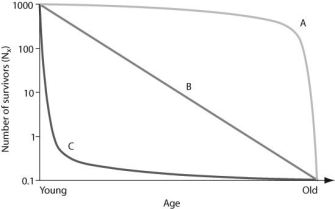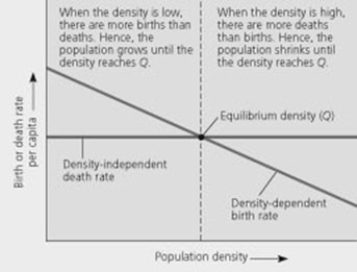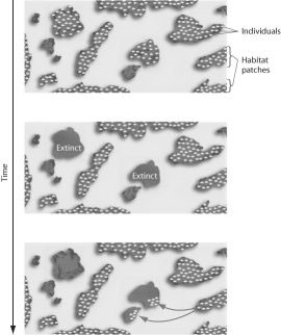A) has a constant per capita population growth rate.
B) quickly reaches its carrying capacity.
C) cycles through time.
D) loses some individuals to emigration.
Correct Answer

verified
Correct Answer
verified
Multiple Choice
Suppose researchers marked 800 turtles and later were able to trap a total of 300 individuals in that population, of which 150 were marked. What is the estimate for total population size?
A) 200
B) 1,050
C) 1,600
D) 2,100
Correct Answer

verified
Correct Answer
verified
Multiple Choice
In which of the following situations would you expect to find the largest number of r-selected individuals?
A) a recently abandoned agricultural field in Colorado
B) a sand dune community south of Lake Michigan
C) an old-growth forest with large, mature trees
D) a coral reef community off the coast of Mexico
Correct Answer

verified
Correct Answer
verified
Multiple Choice
Use the graph to answer the following question.
 In the figure, which of the following survivorship curves most applies to humans living in developed countries?
In the figure, which of the following survivorship curves most applies to humans living in developed countries?
A) curve A
B) curve B
C) curve C
D) curve A or curve B
Correct Answer

verified
Correct Answer
verified
Multiple Choice
According to the logistic growth equation below, = rN
A) the number of individuals added per unit time is greatest when N is close to zero.
B) the per capita population growth rate increases as N approaches K.
C) population growth is zero when N equals K.
D) the population grows exponentially when K is small.
Correct Answer

verified
Correct Answer
verified
Multiple Choice
Use the figure to answer the following question.
 In the figure, imagine a different scenario where the death rate per capita was dependent upon (and positively correlated with) the density of the population, and the birth rate was instead density independent. As the density of the population increased, ________.
In the figure, imagine a different scenario where the death rate per capita was dependent upon (and positively correlated with) the density of the population, and the birth rate was instead density independent. As the density of the population increased, ________.
A) the death rate would decrease and the birth rate would decrease
B) the death rate would increase and the birth rate would decrease
C) the death rate would increase and the birth rate would remain stable
D) the death rate would remain stable and the birth rate would increase
Correct Answer

verified
Correct Answer
verified
Multiple Choice
Analyzing ecological footprints reveals that
A) Earth's carrying capacity would increase if per capita meat consumption increased.
B) current demand by industrialized countries for resources is much smaller than the ecological footprint of those countries.
C) it is not possible for technological improvements to increase Earth's carrying capacity for humans.
D) the ecological footprint of the United States is large because per capita resource use is high.
Correct Answer

verified
Correct Answer
verified
Multiple Choice
Use the figure to answer the following question.
 The figure represents the dynamics of ________.
The figure represents the dynamics of ________.
A) metapopulations
B) extinction
C) emigration
D) both extinction and emigration
Correct Answer

verified
Correct Answer
verified
Multiple Choice
Which pair of terms most accurately describes life history traits for a stable population of wolves?
A) semelparous; r-selected
B) semelparous; K-selected
C) iteroparous; r-selected
D) iteroparous; K-selected
Correct Answer

verified
Correct Answer
verified
Multiple Choice
Population ecologists follow the fate of same-age cohorts to
A) determine a population's carrying capacity.
B) determine the birth rate and death rate of each group in a population.
C) determine if a population is regulated by density-dependent processes.
D) determine the factors that affect the size of a population.
Correct Answer

verified
Correct Answer
verified
Multiple Choice
Which of the following is the best natural example of a uniform pattern of dispersion?
A) bees collecting pollen in a wildflower meadow
B) moss spores floating in the wind to new locations of a forest
C) territorial songbirds in a mature forest during mating season
D) mushrooms growing on the floor of an old growth forest
Correct Answer

verified
Correct Answer
verified
Multiple Choice
Which of the following examples would most accurately measure the dispersion of a population being studied?
A) counting the number of times a one-kilometer transect is intersected by tracks of red squirrels after a snowfall
B) measuring the distance between several burrows within a large prairie dog colony in a grassland
C) measuring the average distance between individuals and their nearest neighbor, and then analyzing the variation and comparing those measurements at larger scales
D) counting the number of zebras from airplane census observations
Correct Answer

verified
Correct Answer
verified
Multiple Choice
Consider two old-growth forests: One is undisturbed while the other is being logged. In which region are species likely to experience exponential growth, and why?
A) old growth, because of stable conditions that would favor exponential growth of all species in the forest
B) old growth, because each of the species is well established and can produce many offspring
C) logged, because the disturbed forest affords more resources for increased specific populations to grow
D) logged, because the various populations are stimulated to a higher reproductive potential
Correct Answer

verified
Correct Answer
verified
Multiple Choice
In 2008, the population of New Zealand was approximately 4,275,000 people. If the birth rate was 14 births for every 1,000 people, approximately how many births occurred in New Zealand in 2008?
A) 6,000
B) 42,275
C) 59,850
D) 140,000
Correct Answer

verified
Correct Answer
verified
Multiple Choice
According to the logistic growth equation, = rN
A) the number of individuals added per unit time is greatest when N is close to zero
B) the per capita growth rate (r) increases as N approaches K
C) population growth is zero when N equals K
D) the population grows exponentially when K is small
Correct Answer

verified
Correct Answer
verified
Multiple Choice
Which statements about K are correct? I.K varies among populations. II.K varies in space. III.K varies in time. IV.K is constant for any given species.
A) only I and III
B) only II and IV
C) only I, II, and III
D) only II, III, and IV
Correct Answer

verified
Correct Answer
verified
Multiple Choice
To measure the population of lake trout in a 250-hectare lake, 400 individual trout were netted and marked with a fin clip, then returned to the lake. The next week, the lake was netted again, and out of the 200 lake trout that were caught, 50 had fin clips. Using the mark-recapture estimate, the lake trout population size could be closest to which of the following?
A) 200
B) 400
C) 1,600
D) 80,000
Correct Answer

verified
Correct Answer
verified
Multiple Choice
In July 2008, the United States had a population of approximately 302,000,000 people. How many Americans were there in July 2009, if the estimated 2008 growth rate was 0.88%?
A) 567,760,000
B) 304,657,600
C) 304,000,000
D) 2,657,600
Correct Answer

verified
Correct Answer
verified
Multiple Choice
Often the growth cycle of one population has an effect on the cycle of another. As moose populations increase, for example, wolf populations also increase. Thus, if we are considering the logistic equation for the wolf population, = rN ,which of the factors accounts for the effect of the moose population?
A) r
B) N
C) rN
D) K
Correct Answer

verified
Correct Answer
verified
Multiple Choice
Long-term studies of Belding's ground squirrels show that immigrants move nearly 2 kilometers from where they are born and become 1%-8% of the males and 0.7%-6% of the females in other populations. On an evolutionary scale, why is this significant?
A) These immigrants make up for the deaths of individuals, keeping the other populations' size stable.
B) These immigrants provide a source of genetic diversity for the other populations.
C) Those individuals that emigrate to these new populations are looking for less crowded conditions with more resources.
D) Gradually, the populations of ground squirrels will move from a clumped to a uniform population pattern of dispersion.
Correct Answer

verified
Correct Answer
verified
Showing 21 - 40 of 69
Related Exams